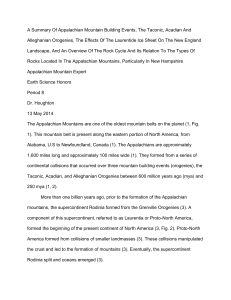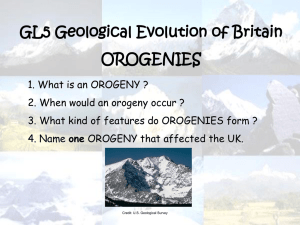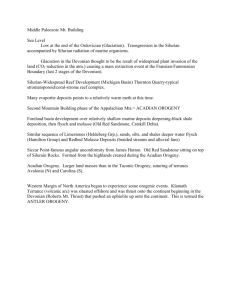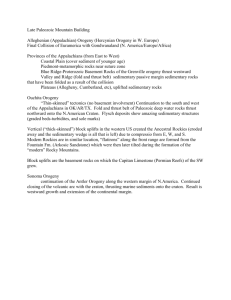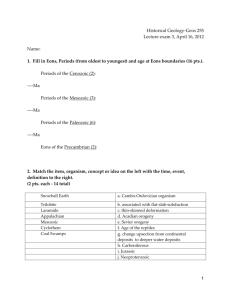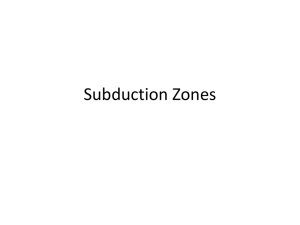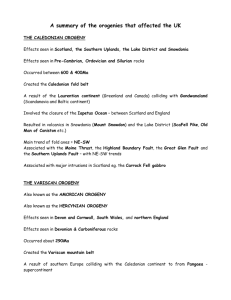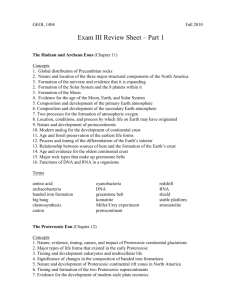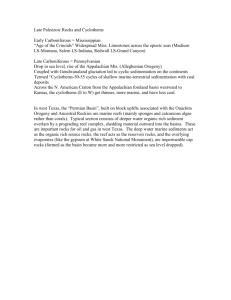GY 112 Lecture Notes
advertisement
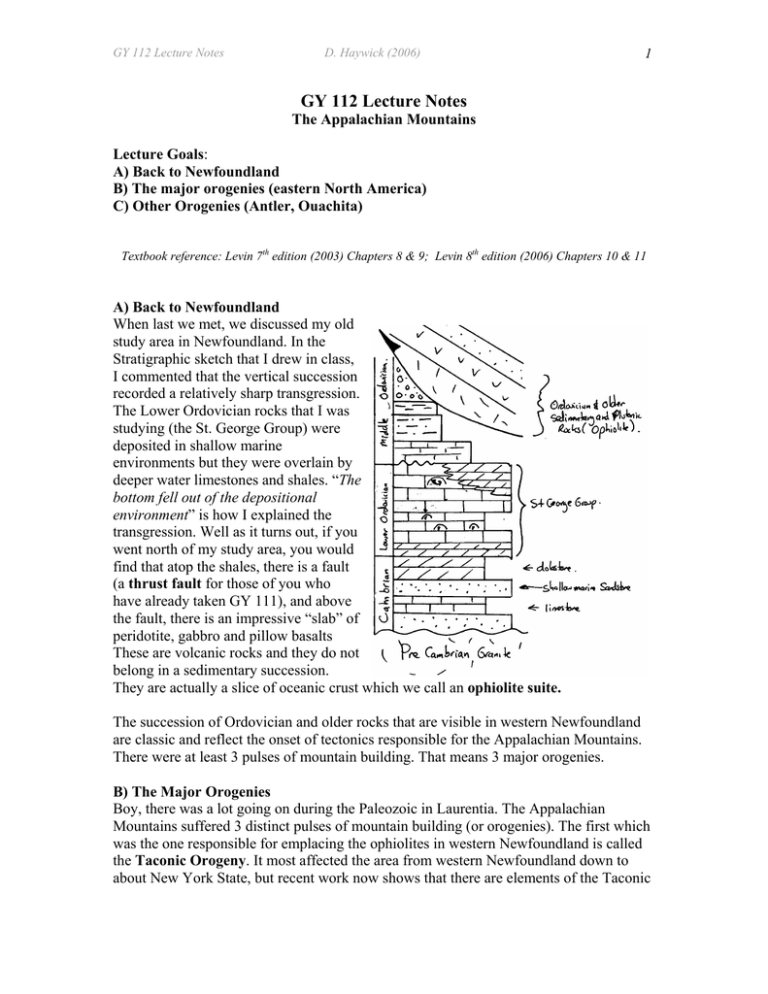
GY 112 Lecture Notes D. Haywick (2006) 1 GY 112 Lecture Notes The Appalachian Mountains Lecture Goals: A) Back to Newfoundland B) The major orogenies (eastern North America) C) Other Orogenies (Antler, Ouachita) Textbook reference: Levin 7th edition (2003) Chapters 8 & 9; Levin 8th edition (2006) Chapters 10 & 11 A) Back to Newfoundland When last we met, we discussed my old study area in Newfoundland. In the Stratigraphic sketch that I drew in class, I commented that the vertical succession recorded a relatively sharp transgression. The Lower Ordovician rocks that I was studying (the St. George Group) were deposited in shallow marine environments but they were overlain by deeper water limestones and shales. “The bottom fell out of the depositional environment” is how I explained the transgression. Well as it turns out, if you went north of my study area, you would find that atop the shales, there is a fault (a thrust fault for those of you who have already taken GY 111), and above the fault, there is an impressive “slab” of peridotite, gabbro and pillow basalts These are volcanic rocks and they do not belong in a sedimentary succession. They are actually a slice of oceanic crust which we call an ophiolite suite. The succession of Ordovician and older rocks that are visible in western Newfoundland are classic and reflect the onset of tectonics responsible for the Appalachian Mountains. There were at least 3 pulses of mountain building. That means 3 major orogenies. B) The Major Orogenies Boy, there was a lot going on during the Paleozoic in Laurentia. The Appalachian Mountains suffered 3 distinct pulses of mountain building (or orogenies). The first which was the one responsible for emplacing the ophiolites in western Newfoundland is called the Taconic Orogeny. It most affected the area from western Newfoundland down to about New York State, but recent work now shows that there are elements of the Taconic GY 112 Lecture Notes D. Haywick (2006) 2 Orogeny much further south (e.g., Georgia). In the south, Taconic events mostly involved intrusions (e.g., plutons composed of granite). In the north, there were also significant compressional events (e.g., thrust faulting). It is now believed that the Taconic Orogeny and the deformation that occurred with it was induced by the collision of an island arc complex with eastern Laurentia. The complex was produced through the subduction of oceanic crust associated with closure of the Proto-Atlantic Ocean (also called the Iapetus Ocean). North America was beginning to experience the collision of other continental masses. The Taconic Orogeny was simply the first strike. Some people regard it as more of a “docking“ or an accretionary event. The island arc was simply “glued” to the outside margin of the continent. But with this docking came uplift and thrust faulting, but little or no regional metamorphism. Many plutons burned their way up through the continental crust at this time too. It may have been a relatively small collision, but it was accompanied by all of the geological consequences that we have come to expect in a plate tectonic-induced orogeny. A second Orogenic event was much more impressive. It occurred during the early Devonian Period and was a follow-up collision to the island arc that hit us during the Taconic Orogeny. This event was a continent-continent collision between North America (Laurentia) and Europe (then called Baltica). It completely closed the Northern Iapetus Ocean, re-deformed some of the rocks previously affected by the Taconic Orogeny, and would have caused a mountain belt the height of the Himalayas in what is today Newfoundland, Nova Scotia, Maine, New York, England, Ireland, Scandinavia and Greenland. In North America, we call this event the Acadian Orogeny. In Europe, they call it the Caledonian Orogeny. However, they are the same event. (Note: the orientation of thrust faults and the intensity of metamorphism are in opposite directions on either side of the suture that would have occurred where the two continents rammed together; see diagram 3). Diagram 3 GY 112 Lecture Notes D. Haywick (2006) 3 I really hope that you all recall that the minute mountains begin to grow, they begin to erode. When Europe and North America collided, the new Appalachian Mountains began to shed tremendous amounts of sediment westward toward the center of the craton. They are a mixed bag of lithologies (breccias, arkose sandstones, conglomerates, quartz arenites etc.), They are Devonian and younger in age and comprise part of the Kaskaskia depositional sequence. Close to the mountains, the sedimentary rocks were largely terrestrial (river conglomerates and sands, red shale etc), but further westward, these rocks undergo facies changes into beach sands and black shales (deep marine). In New York and Pennsylvania, the terrestrial-marine component of Kaskaskia Sequence is called the Catskill Delta (this is a subdivision of the Catskill Clastic Wedge). In other parts of North America, eroding sediment from the Appalachian Mountains did not occur and the shallow marine seaways supported significant amounts of carbonate sedimentation including oolites and reefs (It must have been pretty warm at this time). It was at this time in Western Canada that reefs that today comprise the Leduc Formation were formed. If you remember back to lab 7, this formation is a host for tremendous amounts of petroleum and natural gas. Money, money, money. You gotta love geology! Right about now, most of you are probably asking yourself, “when and how did the southern Appalachian Mountains form?” They resulted from the third and last of the great orogenies to affect eastern North America during the Paleozoic. The Alleghenian Orogeny occurred during the Pennsylvanian Period and resulted from the collision of Africa/South America (then called Gondwanna) with Laurentia. This was the final straw as far as the Iapetus Ocean was concerned. When the Alleghenian Orogeny was finished, the Iapetus Ocean was gone. All that was left were a few slivers of oceanic crust (Ophiolites) that were thrust up onto the sedimentary rocks rocks formerly marking a passive continental margin . This was also the beginning of the last of the great supercontinents. Pangaea had just formed. The series of cartoons that follows this section summarize the events responsible for the formation of the Appalachian Mountains. They have been highly simplified and there are bound to be grievous errors with it. The main point is that you understand the major events responsible for the formation of the Appalachians. After all, you live next door to them. The color image to the right is from http://vulcan.wr.usgs.gov and shows a cross section of the Taconic orogeny. It’s a tad bit better than the one I usually draw for you in class. A similar cross section for the Acadian and Alleghenian Orogenies follows my hand-drawn cartoons (this one’s from http://en.wikipedia.org). GY 112 Lecture Notes D. Haywick (2006) 4 GY 112 Lecture Notes D. Haywick (2006) 5 C) Other Paleozoic Orogenies in North America In western North America, things were pretty quiet tectonically. This is not surprising if you think about it. It is likely that there was some eastward drift to North America during the Paleozoic; that would make the western coastline a passive continental margin. Nevertheless, some tectonic activity started to take place in western North America during the Taconic Orogeny in the east. The Antler Orogeny (Mississippian-Devonian) involved thrust faults from Alberta down to Nevada. Associated with the faulting was the docking of another island arc sequence. The Antler Orogeny probably marks the initiation of subduction of the Pacific Ocean Plate beneath the North American Plate. This was not the major event responsible for the Cordilleran Mountains, but it was the start of process. Mountain building in western North America would reach its maximum during the Mesozoic Era. We’ll come back to this part of our continent at that time. The other orogenic event that we need to discuss in this lecture is the one I know least about. It also confuses me. I am speaking of the Ouachita Orogeny. This event began during the Late Mississippian and continued until the Middle Pennsylvanian. It occurred close to home; in fact, the orogeny induced major basin formation in northern Alabama which you will hear about in the next lecture. The Ouachita Orogeny generated major southward dipping thrust faults from Texas to Mississippi. The event occurred due to a brief encounter with South America (part of Gondwanna) just prior to the full collision with Africa. Paleomagnetic reconstructions suggest that Gondwanna was rotating as it collided with Laurentia and the Ouachita Orogeny occurred as the result of a “glancing blow” when part of South America slide past us. I’ll end this lecture here with one important observation about Paleozoic tectonics in North America. During the Devonian Period, all three coastlines of North America were experiencing major orogenies. To the best of my knowledge, this was the only time in geological history when this occurred. GY 112 Lecture Notes D. Haywick (2006) 6 Important terms/concepts from today’s lecture (Google any terms that you are not familiar with) Island arc Thrust faults Ophiolite Catskill Delta (Catskill Clastic Wedge) Leduc Formation Continental Masses/Oceans Baltica Laurentia Gondwanna Pangaea Iapetus Ocean (Proto-Atlantic) Orogenies Appalachian Mountains (Taconic, Acadian, Alleghenian) Cordilleran Mountains (Antler) Southern USA (Ouachita)
